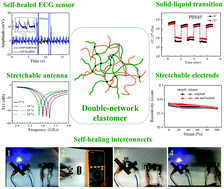Autonomous self-healing, self-adhesive, highly conductive composites based on a silver-filled polyborosiloxane/polydimethylsiloxane double-network elastomer†
Abstract
Self-healing conductive composites have attracted tremendous interest in recent years due to their many important applications, especially in stretchable and reconfigurable electronics as self-healing electrodes. However, the conductivity of these conductive composite electrodes after healing is limited by the poor capability of the self-healing polymer matrix to move the conductive fillers. Herein, we report a novel stretchable self-healing conductive composite based on a polyborosiloxane (PBS)/polydimethylsiloxane (PDMS) double-network (DN) matrix. The chemically cross-linked PDMS network renders the electrode with good elasticity and mechanical robustness while the non-covalent supramolecular interactions in the PBS network provide it with self-healing and self-adhesive capabilities. Moreover, this DN matrix is able to move not only silver nanowires on the composite surfaces, but also heavier conductive fillers such as silver microflakes embedded inside the bulk due to the highly viscous flow of PBS, yielding a bulk resistivity as low as 0.002 Ω cm and achieving 100% restoration of its original conductivity after damage without any external stimulus. This unique combination of high conductivity, autonomous self-healing of both electrical conductivity and mechanical strength, and self-adhesion may endow the novel composite with a wide range of applications.



 Please wait while we load your content...
Please wait while we load your content...